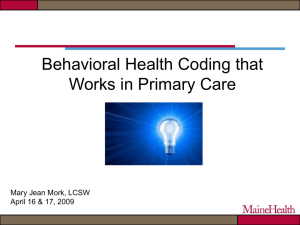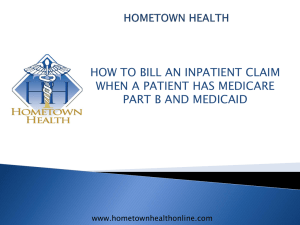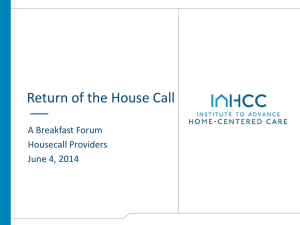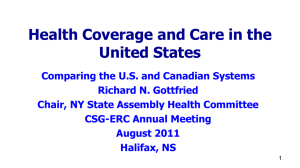medicare reimbursement
advertisement
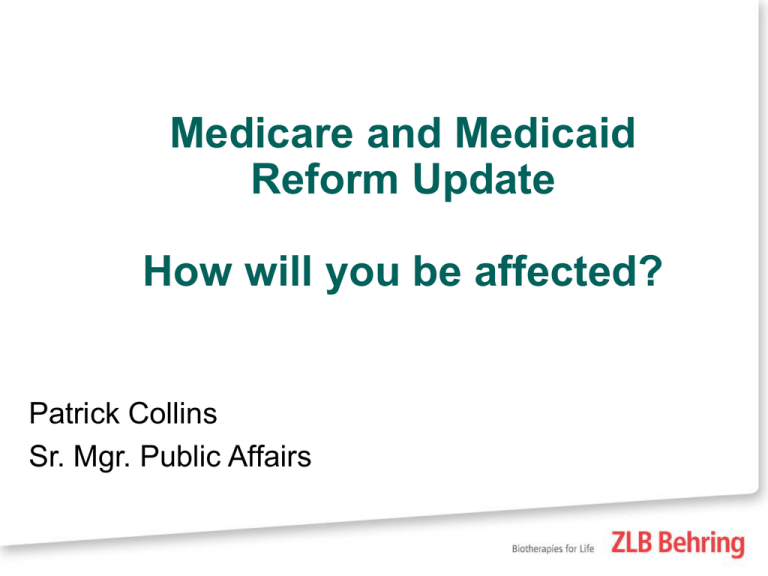
Medicare and Medicaid Reform Update How will you be affected? Patrick Collins Sr. Mgr. Public Affairs Medicare and Hemophilia • Eligibility based on age (65+) or disability • Blood clotting factor is under Medicare Part B • Reimbursement based on Average Sales Price Plus 6% • Additional furnishing fee provided specific solely to blood clotting factors • 2005 - $0.14 per iu • 2006 - $0.146 per iu • Medicare payment based on 80/20 split • 80% of costs picked up by Medicare • 20% is the patient responsibility 2 MEDICARE REIMBURSEMENT FACTOR VIII 3 Product 2006 Q2 Rate 2006 Q1 Rate Factor VIII per i.u. (J 7190) $0.681 $0.659 Factor VIII, recombinant, per i.u. (J 7192) $1.058 $1.064 • Reimbursement is at volume weighted ASP plus 6% based on manufacturer submitted ASPs for 2 quarters previous. For example, Q1 2006 rates are based on volume weighted ASPs from Q3 2005. For blood clotting factors, this payment rate also incorporates an additional add-on fee. • In 2006, an additional $0.146 per unit add-on rate for administration of clotting factor will be implemented for homecare and hemophilia treatment center administration. This will be adjusted in future years by linking any increases to the Consumer Price Index. MEDICARE REIMBURSEMENT – VWD FACTOR 4 Product 2006 Q2 Rates 2006 Q1 Rates Von Willebrand Factor, per i.u. (J7188) $0.877 $0.871 • Reimbursement is at volume weighted ASP plus 6% based on manufacturer submitted ASPs for 2 quarters previous. For example, Q1 2006 rates are based on volume weighted ASPs from Q3 2005. For blood clotting factors, this payment rate also incorporates an additional add-on fee. • In 2006, an additional $0.146 per unit add-on rate for administration of clotting factor will be implemented for homecare and hemophilia treatment center administration. This will be adjusted in future years by linking any increases to the Consumer Price Index. MEDICARE REIMBURSEMENT – FACTOR IX 5 Product 2006 Q2 rates 2006 Q1 rates Factor IX non-recombinant (J 7193) $0.889 $0.892 Factor IX, complex, (J 7194) $0.639 $0.675 Factor IX, recombinant,(J 7195) $0.985 $0.986 • Reimbursement is at volume weighted ASP plus 6% based on manufacturer submitted ASPs for 2 quarters previous. For example, Q1 2006 rates are based on volume weighted ASPs from Q3 2005. For blood clotting factors, this payment rate also incorporates an additional add-on fee. • In 2006, an additional $0.146 per unit add-on rate for administration of clotting factor will be implemented for homecare and hemophilia treatment center administration. This will be adjusted in future years by linking any increases to the Consumer Price Index. Medicare Co-Payment • Person with hemophilia responsible for 20% of total costs of therapy • Many individuals have supplemental insurance to pick up 20% individual responsibility • In cases where 20% could not be paid, providers could in many cases write off as bad debt from uncollected copayment • New reimbursement model makes writing off such debt much more difficult. • Individual without supplemental insurance now may have some difficulty 6 Medicare Co-Payment • 20% individual responsibility for blood clotting factor is financially onerous • Collaboration of HFA, NHF, COTT with ZLB Behring on alternatives to address this situation • Potential solution • Cannot cost the federal government money • Must be accessible and have individual responsibility • Agreed upon solution MediGap 7 Medicare Co-Payment • Proposing MediGap coverage for those on Medicare due to disability • Only those 65 and over have mandatory access to MediGap • Medicare disabled do not have mandatory coverage • 24 states offer MediGap to those on Medicare due to disability • Solution is to have equal MediGap coverage for Medicare beneficiaries 8 Medicare Co-Payment • Seeking federal legislation to equal MediGap eligibility requirements between those 65 and over and those who are disabled • This prevents a state by state appeal • Supplemental insurance for the disabled is needed for Medicare beneficiaries with hemophilia • Individual still has cost share responsibilities (deductibles, premiums, etc.) but far less than 20% of cost of therapy. • MediGap range - $250 - $500 per month • 20% out of pocket - $1667 per month (if $100K annually) 9 Proposed MediGap Statutory Language The bold, underlined text represents the proposed revision to Social Security Act § 1882(s)(2)(A): 10 The issuer of a medicare supplemental policy may not deny or condition the issuance or effectiveness of a medicare supplemental policy, or discriminate in the pricing of the policy, because of health status, claims experience, receipt of health care, or medical condition in the case of an individual for whom an application is submitted prior to or during the 6 month period beginning with the first month as of the first day on which the individual is – (i) 65 years of age or older; or (ii) determined to be disabled (as defined in section 223(d)(1) of the Social Security Act); and (iii) enrolled for benefits under part B. -OR(a) ASSURING AVAILABILITY OF MEDIGAPCOVERAGE(1) IN GENERAL- Section 1882(s) (42 U.S.C. 1395ss(s)) is amended-(A) in paragraph (2)(A), by striking `is 65 years of age or older and is' and inserting `is first'; (B) in paragraph (2)(D), by striking `who is 65 years of age or older as of the date of issuance and'; and (C) paragraph (3)(B)(vi), by striking `at age 65'. (2) EFFECTIVE DATE- The amendments made by paragraph (1) apply terminations of coverage effected on or after the date of the enactment of this Act, regardless of when the individuals become eligible for benefits under part A or part B of title XVIII of the Social Security Act. Federal Impact on Medicaid Greater Reliance on Average Manufacturers Price • Budget Deficit Reduction Act of 2005 • Requires that CMS provide AMP data to states beginning July 1, 2006 • Provide on a monthly basis • Will states use to set reimbursement rates? • Rates less than AWP, which many states still use • Will states provide appropriate “plus” to AMP Retained federal match and federal upper limit for Medicaid prescription drugs at reasonable rate 11 State Medicaid • State government insurance program to insure the poor • States set the rules and regulations • Percent above the poverty level to be eligible • How much to reimburse • What therapies to cover • Federal and state dollars are used to fund Medicaid • Amount of federal “match” depends on the poverty level of a particular state. • Blood clotting factors are covered under state Medicaid programs 12 Nationwide Trends in State Medicaid Restricting Access • Sole Source Programs • Arizona, Utah and Mississippi – Medicaid beneficiaries can obtain BCF only through HTC • Minnesota – program defeated • Florida – expanded to 2 providers • Preferred Drug Lists/Prior Authorization • Iowa – has program in place, most BCF on list • Pennsylvania – program defeated, P&T recommended either all BCF products or no products • Supplemental Rebates • Payment of rebates in order for therapy to be given first preference for Medicaid consideration 13 Nationwide Trends in State Medicaid Reducing Expenditures • Shifting of all Medicaid beneficiaries into Managed Care • Florida? – pilot program being launched in 2 counties for all Medicaid patients • Reduction of reimbursement rates • Maryland – ASP plus 8% • California – ASP plus 20% • Soliciting of state contracts • New York, South Carolina, West Virginia • Imposing ceilings on what will be reimbursed • Many states have implemented Maximum Allowable Cost • Dropping coverage altogether • Tennessee 14 Closing Remarks • Reimbursement is under attack on the state level • Medicaids looking to restrict access, cut costs, and supply clotting factor on the cheap • Medicare access is actually pretty good – furnishing fee has maintained access to therapy • Medicare 20% copayment needs to be addressed • ZLB Behring and the plasma industry (PPTA)committed to fighting for patient access to all blood clotting factors • Open access to all products • Open access to all vendors and sites of service 15
